Kiryu soil is granular-shaped volcanic sand with excellent drainage and aeration ability. It is especially suited for coniferous trees and orchids which prefer a dryer environment for healthy root growth.
What is Kiryu soil?
What is Kiryu soil?
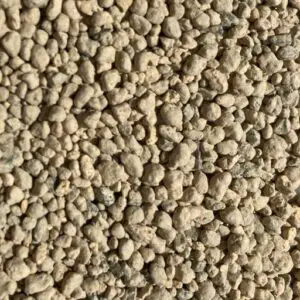
Kiryu soil
Kiryu soil is granular-shaped volcanic sand originating from Mt. Akagi in the Kiryu region, northern Tokyo. Its granular texture provides several benefits for bonsai cultivation, including good aeration within the soil while allowing water to flow freely.
Kiryu soil is light in color, often appearing tan or beige.
While it is called Kiryu “soil”, it’s more like sand rather than soil in the sense that it is a granular material composed of finely divided rock and mineral particles.
Where is Kiryu soil from?
Soil strata
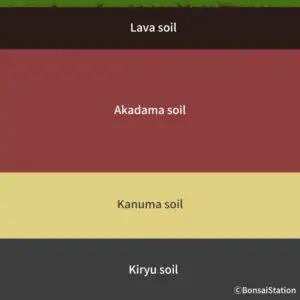
Kiryu soil layer
Kiryu soil is deposited in the lower layer below Akadama and Kanuma soil.
Kiryu Region
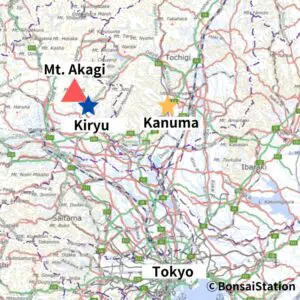
Kiryu region
Kiryu region has a history of volcanic activity with Mt. Akagi, which is still an active volcano now. Roughly about 45,000 years ago, volcanic eruptions from Mt. Akagi deposited layers of volcanic ash and volcanic tuff on the eastern side of the mountain. These deposits in time became Kiryu soil with withering and aging.
Kanuma soil was deposited on top of the Kiryu soil layer by another volcanic eruption from Mt. Akagi, some 35K to 40K years ago.
Key characteristics of Kiryu soil
To fully appreciate the value of Kiryu soil in bonsai cultivation, it’s essential to understand its key characteristics. These qualities set Kiryu soil apart and make it an excellent choice for nurturing bonsai trees to perfection.
Excellent drainage and aeration
One of the standout features of Kiryu soil is its capacity for drainage and aeration. Excess water is swiftly and effectively removed from the root zone and efficient air is present in the soil, reducing the risk of overwatering and root rot which is a common challenge in bonsai care, especially for a beginner.
This characteristic is crucial for maintaining the well-being of bonsai trees.
Adequate water-retention
In addition to excellent drainage and aeration, Kiryu soil offers efficient water-retention ability. Bonsai trees require consistent access to water, and Kiryu soil excels in providing this essential element compared to other soils. It holds onto moisture adequately, ensuring that the roots have access to water when needed.
Moderately acidic
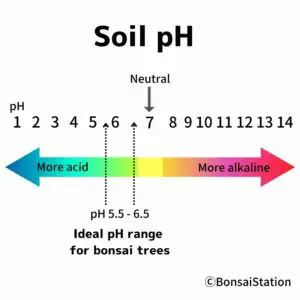
Ideal soil pH for bonsai trees
pH of Kiryu soil is around 6.0. This pH level is considered slightly acidic and makes it suitable for a wide range of bonsai species, as it falls within the generally preferred pH range for most plants, which is between 5.5 to 6.5.
These key characteristics make Kiryu soil a favored medium for bonsai cultivation.
Kiryu soil vs. Kanuma soil
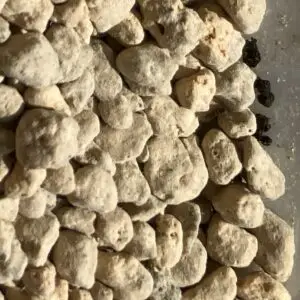
Kanuma soil
While Kiryu soil has gained some popularity among bonsai growers, it is not as widely used as Akadama or Kanuma. Let’s compare Kiryu soil to Kamuma soil to understand when and why it might be the preferred choice.
Comparison table
| Kiryu soil | Kanuma soil | |
| Soil type | Volcanic soil | Volcanic pumice |
| Appearance | Granular & clay-like | Granular & clay-like |
| Color | Beige | Pale yellow |
| Texture | Rough & coarse | Rough & coarse |
| Water-holding capacity | Moderate | High |
| Aeration | High | High |
| Drainage | High | High |
| Soil organic matter level | Low | Low |
| Ability to store nutrients | Moderate | High |
| pH | 6.0 | 5.0-5.5 |
Similarities and differences
Kiryu and Kanuma soils are volcanic materials with similarities in granular appearance, coarse texture, and low organic matter levels.
While both Kiryu and Kanuma soils have excellent aeration and drainage, Kiryu soil has lower water-holding capacity compared to Kanuma soil. This is because Kiryu soil is more “rocky” than Kanuma soil. When we touch it, Kiryu soil is heavier and way harder to break, just like volcanic rock. Kanuma soil, on the other hand, is lighter and more clay-like.
Kanuma soil’s exceptional water retention as well as aeration and drainage make it suitable for many bonsai species and growing conditions, whereas Kiryu soil offers a specific usage where trees/plants prefer dryer soil.
The common uses of Kiryu soil include soil mix for coniferous trees, Kusamono, and orchids.
The choice between the two depends on the specific requirements of your bonsai trees and environmental factors.
Why Kiryu soil is popular

Kiryu soil
When it comes to soil selection, Kiryu soil has earned its reputation as a beloved choice among bonsai growers worldwide. Let’s delve into the reasons why Kiryu soil is popular among those dedicated to the art of bonsai.
Good balance between drainage and water retention
Though not as ideal as Akadama or Kamuma, Kiryu soil has a good balance between drainage and water retention, a characteristic highly desired for bonsai cultivation. Its granular composition allows it to retain moisture while making excess water drain away efficiently.
This balance is crucial for maintaining the health of bonsai trees, as it prevents root rot and overwatering, common pitfalls in bonsai care.
Minimal compaction
Unlike some other common bonsai soils like Akadama and Kanuma that may compact over time, Kiryu soil maintains its structure and porosity for a long time. This prevents the soil from becoming overly dense, which can impede drainage and root growth.
This is especially good for coniferous bonsai trees which need to be repotted only every several years. Those trees potted in Kiryu soil may continue to thrive without the risk of soil compaction.
Promotes healthy root development
One of the cornerstones of successful bonsai cultivation is fostering robust and well-structured root systems. With its well-aerated composition and drainage, Kiryu soil encourages healthy root development. The root systems of bonsai trees grown in Kiryu soil tend to be strong and adaptable, providing a solid foundation for the overall health of the tree.
If you are interested in the usage of sand, including Kiryu soil, in bonsai cultivation, please check the following article.



